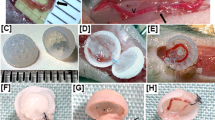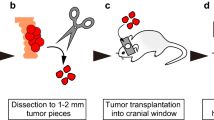Abstract
Blood vessel growth in adult organisms involves the following two fundamental processes: angiogenesis, the proliferation and extension of capillary networks; and arteriogenesis, the growth of functional arteries. We provide a protocol for the evaluation of postnatal arteriogenesis and angiogenesis in a mouse model of hind-limb ischemia. Surgical ligation of the femoral artery at a specific site triggers arteriogenesis of small, pre-existing collateral arteries into functional conduit vessels proximally and ischemic angiogenesis distally. The vascular response to hind-limb ischemia can be readily evaluated by laser Doppler-based perfusion measurements, histological quantification of arteriogenesis and angiogenesis or whole-mount visualization of arteries in limb muscles. Depending on the experimental design, the protocol takes between 4 and 29 d to complete; however, the net working time is about 2 d per mouse. The concurrent and specific analysis of postnatal angiogenesis and arteriogenesis in the same animal is a unique feature of the protocol.
This is a preview of subscription content, access via your institution
Access options
Subscribe to this journal
Receive 12 print issues and online access
$259.00 per year
only $21.58 per issue
Buy this article
- Purchase on Springer Link
- Instant access to full article PDF
Prices may be subject to local taxes which are calculated during checkout











Similar content being viewed by others
References
World Health Organization. in Fact sheet No. 317 Feb. 2007 (World Health Organization, 2007) (http://www.who.int/mediacentre/factsheets/fs317/en/index.html).
Adams, R.H. & Alitalo, K. Molecular regulation of angiogenesis and lymphangiogenesis. Nat. Rev. Mol. Cell. Biol. 8, 464–478 (2007).
Carmeliet, P. Angiogenesis in health and disease. Nat. Med. 9, 653–660 (2003).
Carmeliet, P. Mechanisms of angiogenesis and arteriogenesis. Nat. Med. 6, 389–395 (2000).
Schaper, W. Collateral circulation: past and present. Basic Res. Cardiol. 104, 5–21 (2009).
Heil, M. & Schaper, W. Influence of mechanical, cellular, and molecular factors on collateral artery growth (arteriogenesis). Circ. Res. 95, 449–458 (2004).
Heil, M., Eitenmuller, I., Schmitz-Rixen, T. & Schaper, W. Arteriogenesis versus angiogenesis: similarities and differences. J. Cell. Mol. Med. 10, 45–55 (2006).
Eitenmuller, I. et al. The range of adaptation by collateral vessels after femoral artery occlusion. Circ. Res. 99, 656–662 (2006).
Limbourg, A. et al. Notch ligand Delta-like 1 is essential for postnatal arteriogenesis. Circ. Res. 100, 363–371 (2007).
Schaper, W., Jageneau, A. & Xhonneux, R. The development of collateral circulation in the pig and dog heart. Cardiologia 51, 321–335 (1967).
Arras, M. et al. Monocyte activation in angiogenesis and collateral growth in the rabbit hindlimb. J. Clin. Invest. 101, 40–50 (1998).
Jacobi, J. et al. Adenoviral gene transfer with soluble vascular endothelial growth factor receptors impairs angiogenesis and perfusion in a murine model of hindlimb ischemia. Circulation 110, 2424–2429 (2004).
Kondoh, K. et al. Conduction performance of collateral vessels induced by vascular endothelial growth factor or basic fibroblast growth factor. Cardiovasc. Res. 61, 132–142 (2004).
Ziegelhoeffer, T. et al. Bone marrow-derived cells do not incorporate into the adult growing vasculature. Circ. Res. 94, 230–238 (2004).
Scholz, D. et al. Contribution of arteriogenesis and angiogenesis to postocclusive hindlimb perfusion in mice. J. Mol. Cell. Cardiol. 34, 775–787 (2002).
Simons, M. Angiogenesis: where do we stand now? Circulation 111, 1556–1566 (2005).
Simons, M. & Ware, J.A. Therapeutic angiogenesis in cardiovascular disease. Nat. Rev. Drug Discov. 2, 863–871 (2003).
Couffinhal, T. et al. Mouse model of angiogenesis. Am. J. Pathol. 152, 1667–1679 (1998).
Niiyama, H., Huang, N.F., Rollins, M.D. & Cooke, J.P. Murine model of hindlimb ischemia. J. Vis. Exp. 23 (2009) (http://www.jove.com/index/details.stp?id=1035,doi:10.3791/1035).
Hedrich, H. The Laboratory Mouse. (Elsevier Academic Press, New York, 2004), 120–133.
Hirsch, A.T. et al. ACC/AHA 2005 guidelines for the management of patients with peripheral arterial disease (lower extremity, renal, mesenteric, and abdominal aortic): executive summary a collaborative report from the American Association for Vascular Surgery/Society for Vascular Surgery, Society for Cardiovascular Angiography and Interventions, Society for Vascular Medicine and Biology, Society of Interventional Radiology, and the ACC/AHA Task Force on Practice Guidelines (Writing Committee to Develop Guidelines for the Management of Patients With Peripheral Arterial Disease) endorsed by the American Association of Cardiovascular and Pulmonary Rehabilitation; National Heart, Lung, and Blood Institute; Society for Vascular Nursing; TransAtlantic Inter-Society Consensus; and Vascular Disease Foundation. J. Am. Coll. Cardiol. 47, 1239–1312 (2006).
Jakobsson, A. & Nilsson, G.E. Prediction of sampling depth and photon path length in laser Doppler flowmetry. Med. Biol. Eng. Comput. 31, 301–307 (1993).
Chalothorn, D., Clayton, J.A., Zhang, H., Pomp, D. & Faber, J.E. Collateral density, remodeling, and VEGF-A expression differ widely between mouse strains. Physiol. Genomics 30, 179–191 (2007).
Helisch, A. et al. Impact of mouse strain differences in innate hindlimb collateral vasculature. Arterioscler. Thromb. Vasc. Biol. 26, 520–526 (2006).
Cotran, R.S., Robbins, S.L. & Kumar, V. In Robbins Pathologic Basis of Disease, 5th edn. (eds. Cotran, R.S, Robbins, S.L. and Kumar, V.) 1–34 (W.B. Saunders, Philadelphia, PA, 1994).
Demicheva, E., Hecker, M. & Korff, T. Stretch-induced activation of the transcription factor activator protein-1 controls monocyte chemoattractant protein-1 expression during arteriogenesis. Circ. Res. 103, 477–484 (2008).
Schierling, W. et al. Increased intravascular flow rate triggers cerebral arteriogenesis. J. Cereb. Blood Flow Metab. 29, 726–737 (2009).
Gerhardt, H. et al. VEGF guides angiogenic sprouting utilizing endothelial tip cell filopodia. J. Cell. Biol. 161, 1163–1177 (2003).
McDonald, A.G., Yang, K., Roberts, H.R., Monroe, D.M. & Hoffman, M. Perivascular tissue factor is down-regulated following cutaneous wounding: implications for bleeding in hemophilia. Blood 111, 2046–2048 (2008).
Brazelton, T.R. & Blau, H.M. Optimizing techniques for tracking transplanted stem cells in vivo . Stem Cells 23, 1251–1265 (2005).
Spalteholz, W. Ueber das Durchsichtigmachen von menschlichen und tierischen Präparaten und seine theoretischen Bedingungen; nebst Anhang: Ueber Knochenfärbung 2nd edn., erweiterte Aufl. (Hirzel, Leipzig, Germany, 1914).
Denk, H., Künzle, H., Plenk, H., Rüschoss, J. & Sellner, W. In Mikroskopische Technik 17th edn. (eds. Romeis, B. & Boeck, P.) 235–236 (Urban & Schwarzenberg, München, Baltimore, 1989).
Acknowledgements
This work is supported by funds from the Deutsche Forschungsgemeinschaft (German Excellence Cluster Rebirth and DFG Li948/4-1) to FPL and from the Bundesministerium für Bildung und Forschung (IFB-Tx) to AL.
Author information
Authors and Affiliations
Contributions
A.L., T.K. and L.C.N. designed and carried out the experiments and prepared the manuscript; W.S. and H.D. advised in experiments and edited the manuscript; and F.P.L. designed experiments, analyzed data and prepared the manuscript.
Corresponding author
Rights and permissions
About this article
Cite this article
Limbourg, A., Korff, T., Napp, L. et al. Evaluation of postnatal arteriogenesis and angiogenesis in a mouse model of hind-limb ischemia. Nat Protoc 4, 1737–1748 (2009). https://doi.org/10.1038/nprot.2009.185
Published:
Issue Date:
DOI: https://doi.org/10.1038/nprot.2009.185
This article is cited by
-
FNIP1 abrogation promotes functional revascularization of ischemic skeletal muscle by driving macrophage recruitment
Nature Communications (2023)
-
CD133+ endothelial-like stem cells restore neovascularization and promote longevity in progeroid and naturally aged mice
Nature Aging (2023)
-
Increasing angiogenic efficacy of conditioned medium using light stimulation of human adipose-derived stem cells
Communications Biology (2022)
-
The C5a/C5a receptor 1 axis controls tissue neovascularization through CXCL4 release from platelets
Nature Communications (2021)
-
Macrophage M2 polarization induced by exosomes from adipose-derived stem cells contributes to the exosomal proangiogenic effect on mouse ischemic hindlimb
Stem Cell Research & Therapy (2020)
Comments
By submitting a comment you agree to abide by our Terms and Community Guidelines. If you find something abusive or that does not comply with our terms or guidelines please flag it as inappropriate.



